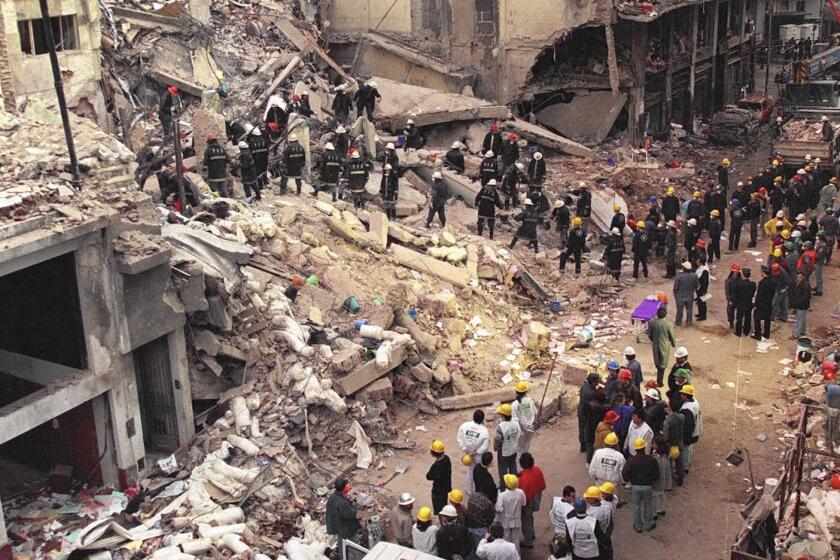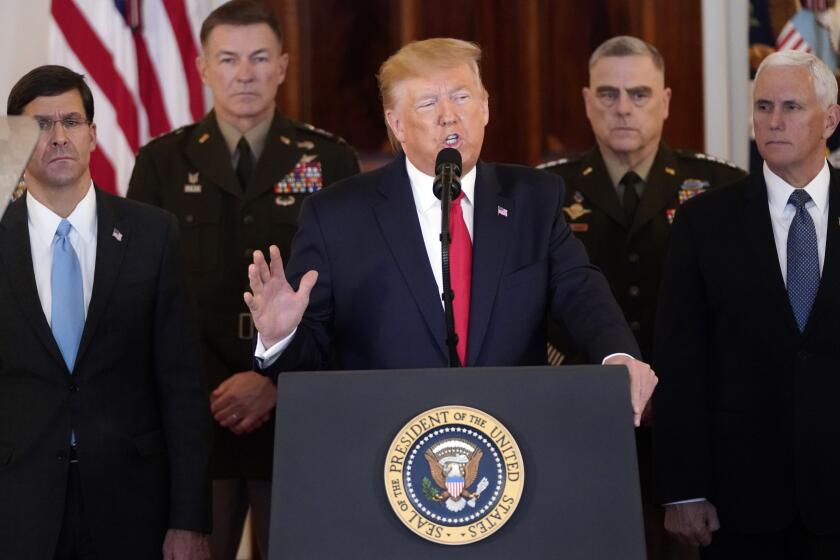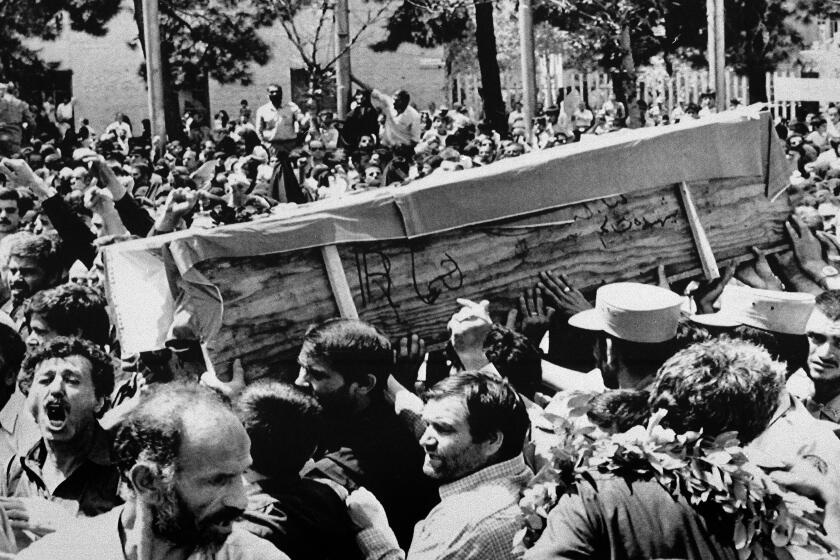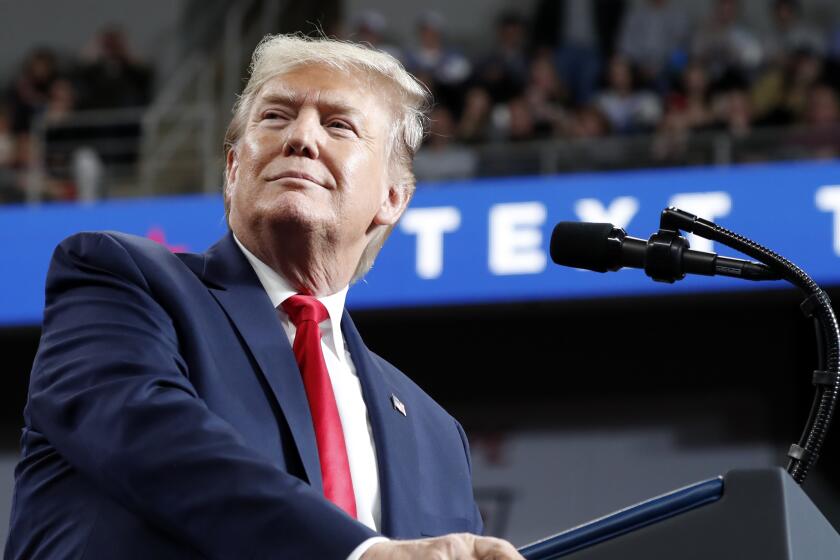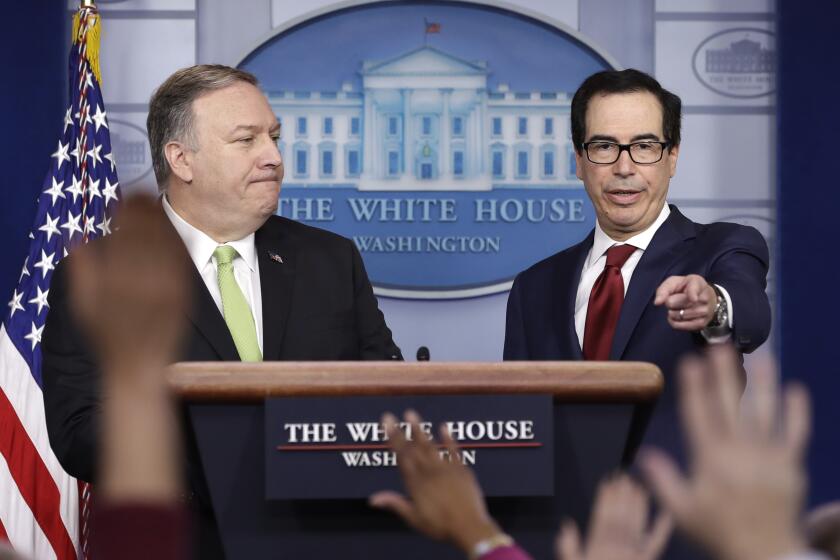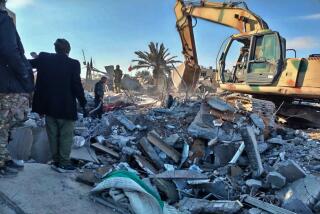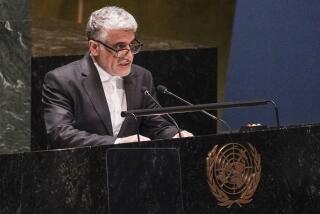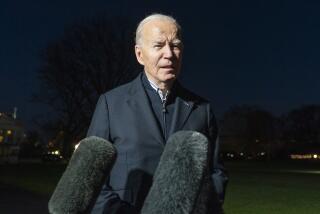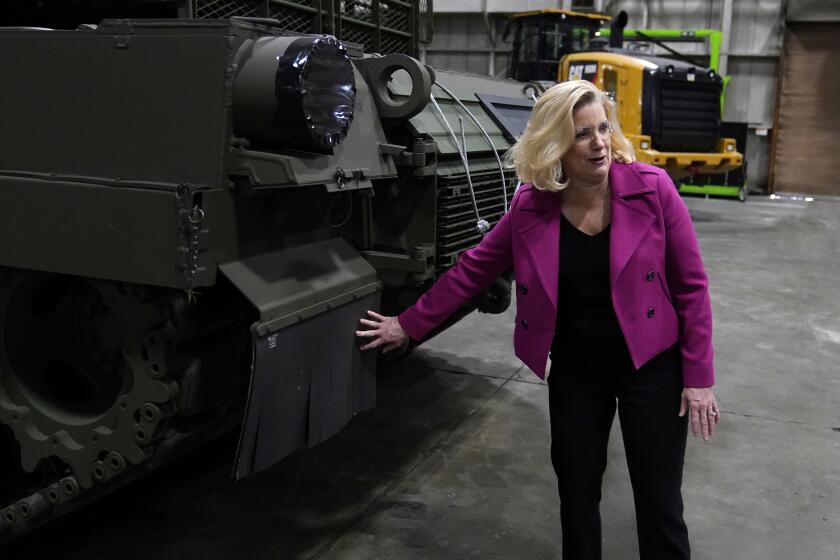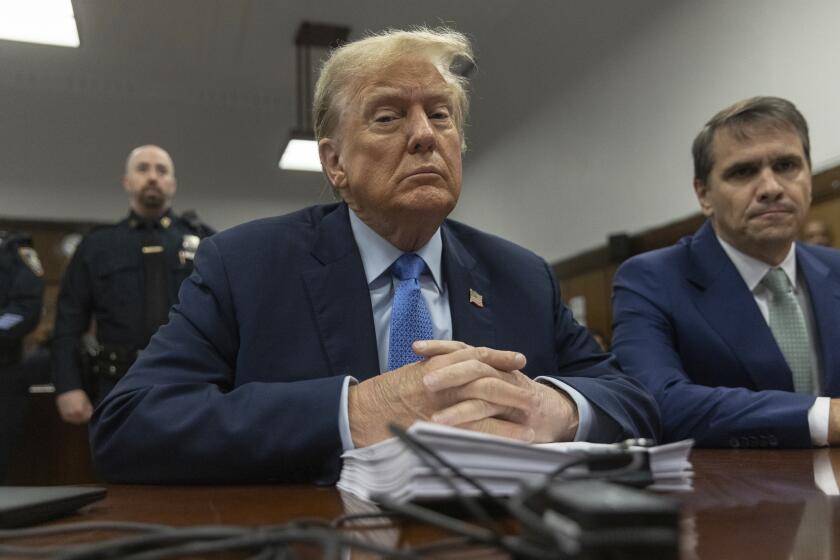On the streets of Tehran, relief for now at no wider conflict with U.S.
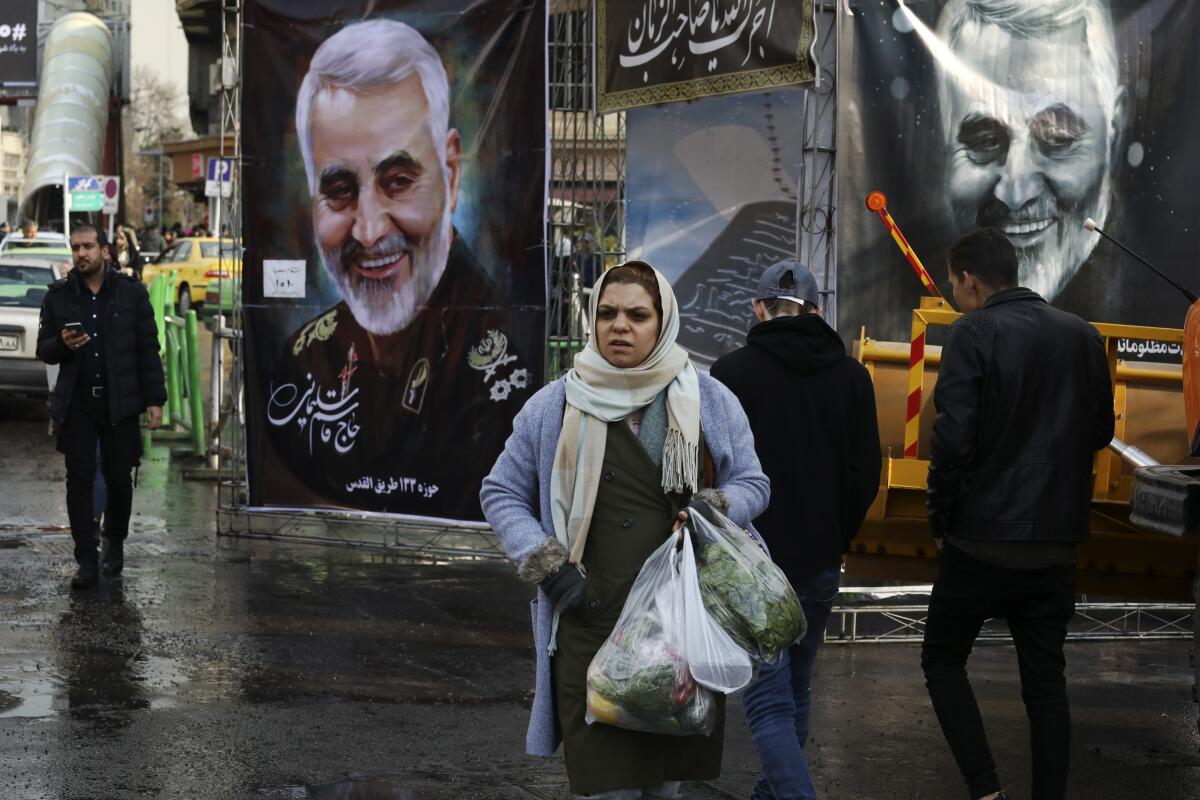
Iranian newspapers proclaimed the country’s attack on U.S. forces in Iraq to be “a dark night for Americans,” and Washington’s “first admission of failure in history.” On the bustling streets of Tehran, however, there was relief Thursday that neither side appeared primed for war.
“War is not something like the ‘Call of Duty’ game,” said Dara Shojaei, a 23-year-old architecture student. “It’s not a game you can play to win. There’s no winner.”
But with the relief came some mixed feelings about how far Iran should go to avenge the killing of Revolutionary Guard Gen. Qassem Suleiman, the country’s most powerful commander, who was slain by a U.S. drone strike in Baghdad last week. His death brought an outpouring of grief and outrage across the country, and Iran responded early Wednesday by firing a barrage of ballistic missiles at two Iraqi military bases housing American troops.
The dramatic blast of more than a dozen missiles caused no casualties at the two bases, although U.S., Canadian and British officials said Thursday that evidence showed that an Iranian anti-aircraft missile probably downed a Ukrainian jetliner near Tehran just a few hours after Iran launched its attack on the Iraqi bases. They said the strike, which killed all 176 people on board, could have been a mistake.
Investigators from Iran’s Civil Aviation Organization offered no immediate explanation for the disaster. A preliminary Iranian investigative report released Thursday said that the airliner pilots never made a radio call for help and that the aircraft was trying to turn back for the airport when the burning plane went down.
The Trump administration says Hezbollah is an active threat in Latin America. But it hasn’t presented much evidence of that.
Even though U.S. and Iraqi officials said there had been no casualties in the Iranian missile strike on the Iraqi bases, Iranian state TV claimed that some 80 U.S. soldiers had been killed — a death toll repeated Thursday by a top Iranian general.
At the White House, President Trump said Iran “appears to be standing down,” while Iran’s Supreme Leader Ayatollah Ali Khamenei described the missile attack as “a slap” against America.
Across state media, the Iranian government portrayed its retaliatory strike as a victory.
The hard-line Kahyan newspaper said Iran’s missiles damaged U.S. dignity, while another pro-regime daily, Javan, said it was the first admission of failure by the United States in its history.
The reformist daily Aftab Yazd led with the headline: “Iran’s slap makes Trump withdraw and declare peace.” Another reformist daily paper, Arman Melli, called it “A dark night for Americans.”
The same day Gen. Qassem Suleimani was killed in Iraq, American forces also carried out an unsuccessful strike targeting a senior Iranian military official in Yemen, according to the Washington Post.
While Tehran claims that the missile strikes killed Americans, Western media reports to the contrary have filtered through to some Iranian internet users, despite government controls on social media.
Ali Azimi, a 41-year-old engineer, said Iran’s retaliation was “excessive.”
“We shouldn’t have taken revenge because they could have hit and destroyed us,” he said.
In somewhat mixed messages Thursday, President Hassan Rouhani warned of a “very dangerous response” if the U.S. makes “another mistake,” but a senior commander vowed even “harsher revenge.”
Mohammad Taghizadeh, a 30-year-old resident of Tehran, described the Iranian actions as a “good start.”
“As the supreme leader said, it was a slap. It was not satisfying and bigger things should happen,” he said.
Suggestions that Iran shot down a Ukrainian airliner are a grim echo of the accidental shootdown of an Iranian jet by the U.S. over 30 years ago.
He also echoed a familiar refrain of deep suspicion toward Washington.
“Trump is trying to boost the self-confidence of Americans, and I think he is lying,” Taghizadeh said about U.S. claims of no casualties. He added that because Trump is running for reelection, he “can’t say that we have had our soldiers killed.”
Gen. Amir Ali Hajizadeh, who leads the country’s aerospace program, said in remarks carried Thursday by the semi-official Tasnim news agency that the goal of “Operation Martyr Suleimani,” as the retaliatory campaign was dubbed, was not to kill anyone, but to “strike the enemy’s military machine.” Still, he repeated that the U.S. suffered mass casualties.
Gen. Ali Fadavi, acting commander of the Revolutionary Guard, was quoted by Tasnim as describing the attack as a clear sign of Iran’s unique strength.
“We stand against the enemy and we respond,” he said. “No [other] country has the capacity to express its will against the United States.”
Across the country, ordinary Iranians are bracing for even more hard times after Trump vowed to keep up the maximum pressure campaign on Tehran.
President Trump used his first campaign election rally of 2020 to argue that he served up “American justice” by ordering a drone strike to take out an Iranian general
Tensions have been running high in the Persian Gulf since Trump pulled the U.S out of Iran’s nuclear deal with world powers in 2018 and reimposed punishing sanctions. The sanctions have made it difficult for Iran to sell its oil internationally, which has affected the government’s ability to pay for subsidies and pushed prices up.
“Over the past three days, there was not a single day that we woke up and didn’t see negative news,” said Shabnam Mohtashami, 43, of Tehran. “The thought of what could happen again and what calamities we might suffer is very scary.”
But she said that “domestic [economic] problems put even more pressure on us than if a war will happen or not.”
Iran’s government faced widespread protests in November over rising prices, with many apparently also outraged by Iran’s spending on interventions in Syria, Lebanon, Iraq and other countries while its own economy falters.
More than 300 people were killed in the antigovernment protests, according to rights organization Amnesty International. During the violence and in the days that followed, Iranian authorities blocked access to the internet.
Suleimani’s killing, however, helped rally the public around the leadership again.
The Trump administration announced new economic sanctions on Iran, although the 1,000 already in place have not forced Tehran to change its policies.
Millions of Iranians were stunned by Suleimani’s killing, and they poured into the streets as his casket was paraded through several cities. The general was seen by many in Iran as a national hero whose command of the Revolutionary Guard’s Quds Force, which oversees Shiite proxy militias, projected Iranian power in the face of U.S. pressure.
Ali Fathollah-Nejad, an Iran expert at the Brookings Doha Center, said the Iranian government has used Suleimani’s death to create “a nationalistic moment” and keep the flames of conflict with Washington simmering without risking a full-blown war that might endanger the regime’s survival.
He said the killing angered people beyond the government’s traditional base because of Suleimani’s state-crafted image in recent years as a patriotic hero defending the homeland from Sunni extremists, like the Islamic State group.
“In the short term this leads to regime stabilization, with the deep-seated socioeconomic and political grievances that fueled the protests pushed under the surface at a moment when a lot of Iranians fear a full-blown war,” Fathollah-Nejad said.
More to Read
Start your day right
Sign up for Essential California for news, features and recommendations from the L.A. Times and beyond in your inbox six days a week.
You may occasionally receive promotional content from the Los Angeles Times.
